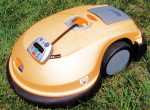Search engine visitors - click here to access entire "$ensible Home" web site
Click here to see a descriptive illustration showing several of the new types of battery, robot and gasline mowers
Dear Jim: I really don't like cutting grass, so I am thinking about a rechargeable automatic robot mower or a quiet, no-fumes cordless mower. What is the best type to get and will my electric bills be higher? - Bob H.

A: There are several designs of automatic robot mowers that cut your lawn while you relax on your deck. The prices of some robot models have dropped to only about $100 more than walk-behind gasoline mowers.
I use a rechargeable cordless mower in my 1/3-acre backyard. There are no exhaust fumes, it always starts and it is quiet. The first time I used it, it was so quiet, my neighbors wondered why I was pushing a mower around without starting it. I can talk on my cell phone while I mow.
Depending on how often you mow, a cordless or robot mower uses only $10 to $20 of electricity per year. When you compare this to typical gasoline mower operating costs (gas, tune-ups, oil changes), using a cordless mower is a bargain. Also, they don't pollute the air nearly as much.
Automatic robot mowers work similar to an invisible fence for a dog. You lay a low-voltage wire, attached with tiny stakes, on the ground around the perimeter of your yard. When the robot mower gets to the wire, it senses the wire and turns 45 degrees. It continues this pattern until your entire yard is cut.
There is a pressure-sensitive bumper around the edge of the robot mower. When it bumps an object, such as a tree, house wall or deck post, the bumper signals it to change direction. One can cut a third to a half-acre lawn on each recharge. They operate extremely quietly and are durable.
A self-charging robot mower senses when the battery charge is low and it finds its recharging station. There it connects itself and starts cutting again after the battery is recharged. With a non-self-charging model, when the lawn is completely cut, you steer it with a controller to any electrical wall outlet and plug it in to recharge.
The best walk-behind cordless mowers use a 24-volt battery. This is a good compromise between cutting time and weight. In all but the thickest growth period in early spring, I do my entire yard on one charge. It recharges to 70 percent power in four hours or fully in 24 hours.
If you are not quite ready for a robot mower, but want a self-propelled one, select a gasoline mower with an overhead valve (OHV) engine. OHV's produce less air pollution and are powerful.
The most convenient self-propelled mowers use an automatic variable-speed design to move at any pace you walk. If you start walking faster than the mower, this puts pressure on the handle and the mower speeds up.
Instant Download Update Bulletin No. 845 - buyer's guide of 10 rechargeable cordless and gasoline walk-behind and robot mower manufacturers listing speeds, OHV or L-head engine, prices, horsepower, cutting width, weight, cutting height, lawn grass selector guide showing 10 different types and mulching mowing tips.
Dear Jim: We have our business in a 100-year-old two-story house. We only use the first floor. The ceiling has exposed beams, but no insulation. What can we do to insulate it to stop the heat from the roof? - Mike F.
A: Adding insulation will help more during the winter than during the summer. Seal all the air leaks in the ceiling and put insulation on the floor on the second level. Rolling out fiberglass blankets would be easiest.
To stop the summer heat, make sure you have adequate attic ventilation to exhaust the hot air. You might also consider stapling reflective foil directly under the roof or paint the underside with low-emissivity paint.